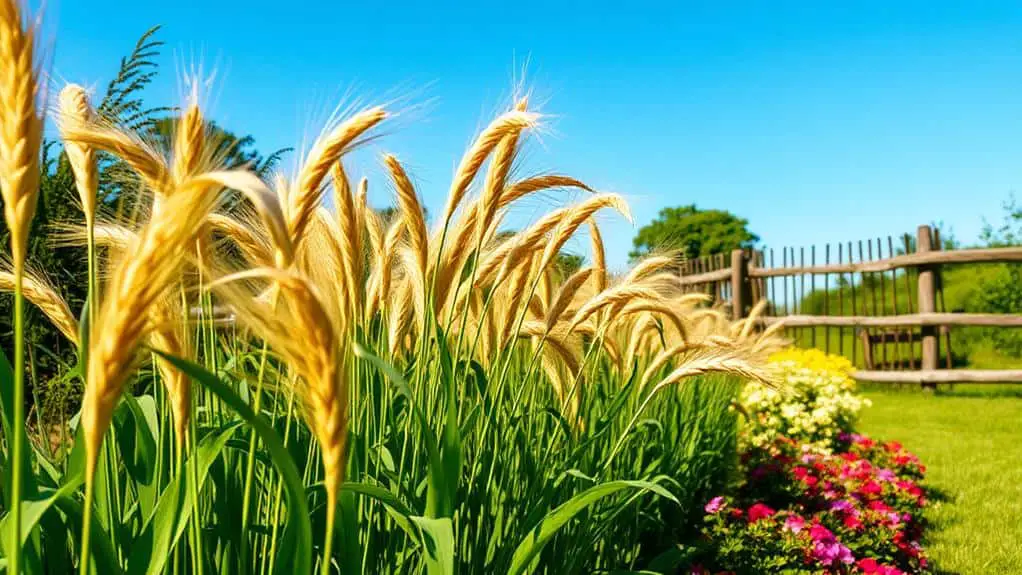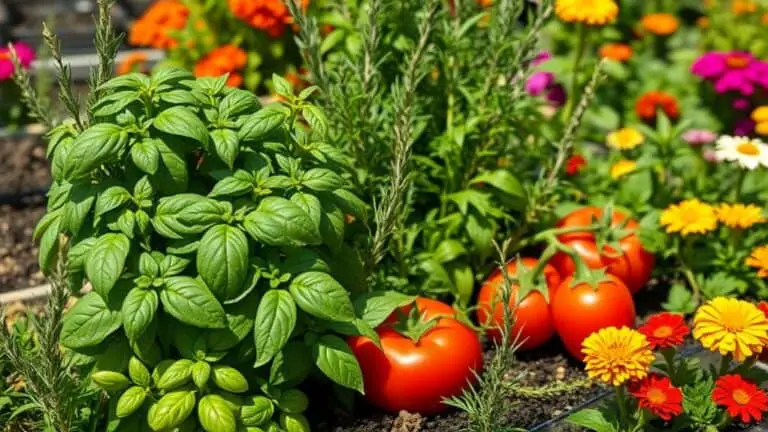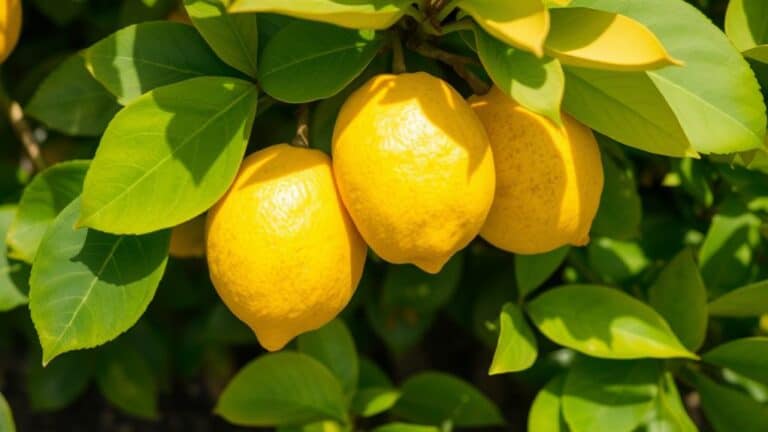Why You Should Grow Wheat In Your Garden
I've found that growing wheat in my garden has been an incredibly rewarding experience with numerous benefits. Not only does it enhance soil health, but it also provides a nutritious, chemical-free food source for my family and poultry. Wheat's deep roots improve soil structure and aeration, preventing erosion with minimal maintenance required. Freshly milled flour from homegrown wheat is richer in flavor and nutrients, making homemade baked goods even more delightful. There's also the added satisfaction of contributing to biodiversity by cultivating heirloom varieties. Curious about how to get started and what to expect?
Benefits of Growing Wheat
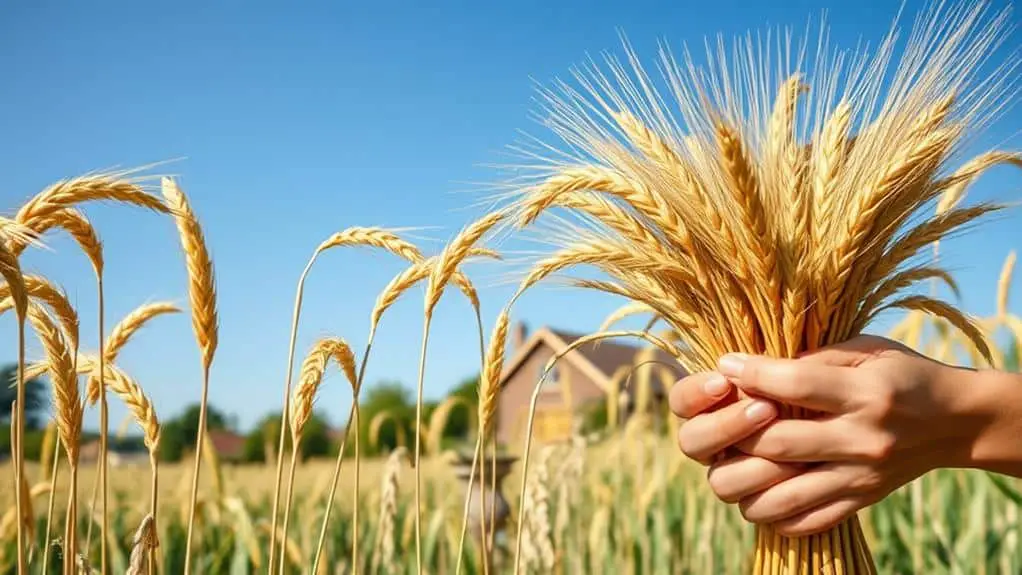
Growing wheat in your garden offers a multitude of benefits that go beyond just having a fresh supply of flour. When you grow wheat, you gain access to homegrown flour, free from chemicals and full of flavor. A single square foot can yield up to 60-80 grain heads, giving you about half a cup of flour.
Wheat also improves soil structure due to its deep roots, which aerate the soil. This helps future crops and reduces the need for chemical fertilizers. Plus, wheatgrass, a byproduct of growing wheat, is nutrient-dense and great for detoxification and digestion.
Growing wheat adds beauty and biodiversity to your garden, especially with unique heirloom varieties like Utrecht Blue.
Soil Improvement
Improving your garden's soil quality can be as simple as planting wheat.
Wheat's fine roots add organic matter to the topsoil, boosting soil fertility and promoting healthy plant growth. Additionally, its deep root system enhances soil aeration and structure, which helps water infiltrate better and supports root development.
Here are four reasons why planting wheat improves soil health:
- Organic matter: Wheat roots decompose, enriching the soil.
- Cover crop: It prevents winter erosion and suppresses weeds.
- Nitrogen-rich: Young wheat can be a green input, reducing synthetic fertilizer needs.
- Compost: Dried stalks can serve as carbon-rich compost or mulch.
Crop Rotation Advantages
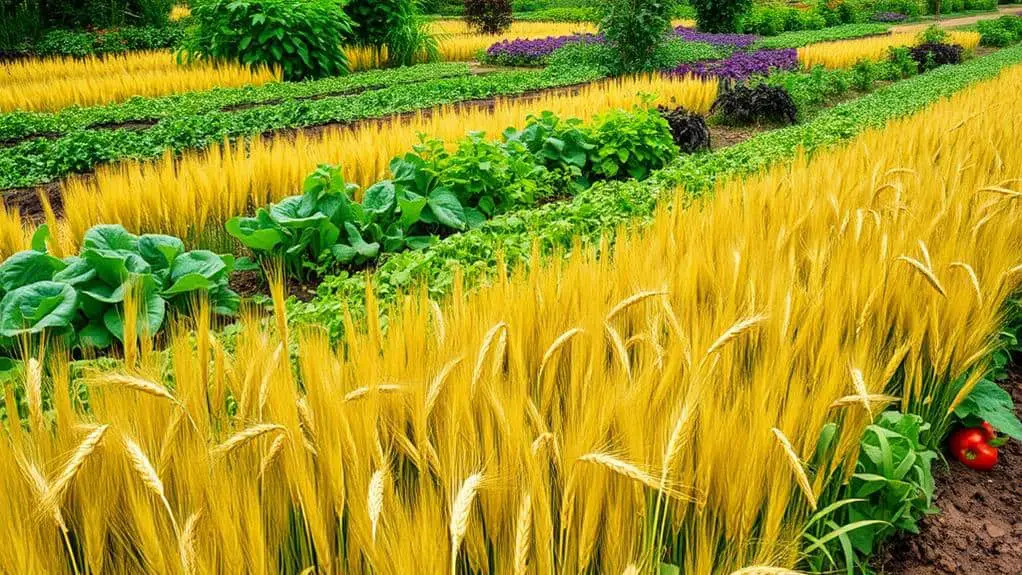
Have you ever wondered how you can enhance your garden's health and productivity? Implementing crop rotation with wheat can be a game changer.
By rotating wheat with other crops, you improve soil health and nutrient availability. Wheat's deep roots help aerate the soil and enhance its structure, which benefits shallow-rooted crops that follow.
This practice also interrupts the cycles of pests and diseases, reducing the need for chemical pesticides and promoting a healthier garden ecosystem. Adding wheat to your rotation plan adds diversity, making your garden more resilient.
Plus, better soil health from crop rotation can lower fertilizer costs. So, why not give it a try and see the benefits for yourself?
Low Maintenance
Growing wheat is a smart choice for a low-maintenance garden.
It doesn't need much fertilizer, and it's pretty tough when it comes to pests and diseases.
You can enjoy a healthy crop without spending a lot of time on upkeep.
Minimal Fertilizer Requirements
Wheat's resilience makes it an excellent choice for gardeners looking for low-maintenance crops. One of the best things about growing wheat is its minimal fertilizer requirements. It doesn't need much to thrive, which means less work and expense for you.
Here are four reasons why wheat is a great option:
- Minimal Fertilizer: Wheat requires very little fertilizer, reducing costs and effort.
- Soil Health: Its fine roots improve topsoil and add organic matter naturally.
- Nitrogen: Young wheat can act as nitrogen-rich green inputs, boosting soil fertility.
- Drought Tolerance: Mature wheat plants are drought-tolerant, needing less water and fertilizer.
Low Pest and Disease
One of the remarkable benefits of growing wheat is its low susceptibility to pests and diseases, making it a low-maintenance option for any gardener. Wheat is adaptable to various climates, which means it's resilient to both cold and drought conditions. This crop requires minimal care and attention compared to others. When young, wheat plants show strong drought tolerance, and mature plants can handle tough weather with ease. As a winter cover crop, wheat helps protect soil from erosion and suppresses weeds, further reducing the need for maintenance.
| Benefit | Description |
|---|---|
| Pests | Low susceptibility |
| Diseases | Minimal risk |
| Climate Adaptability | Withstands cold and drought |
| Soil Protection | Prevents erosion and suppresses weeds |
Growing wheat simplifies garden management, making it a truly rewarding choice.
Homegrown Grain
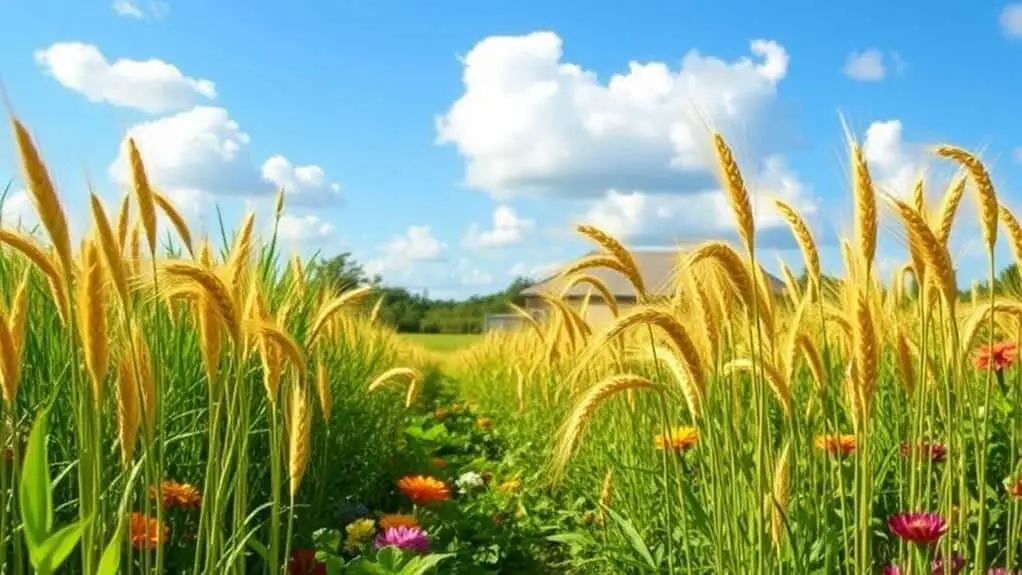
When you grow wheat in your garden, you open up a world of possibilities for homemade baking with fresh, preservative-free flour.
You can also use the young wheatgrass for nutrient-rich shots that boost your health.
Plus, if you have chickens, homegrown wheat makes excellent, natural poultry feed.
Flour for Homemade Baking
There's something incredibly satisfying about using flour you've milled yourself from wheat grown in your own garden.
Fresh wheat harvested at the right time means your homemade flour is as fresh as it gets. Whole grain flour from your own garden is richer in nutrients and flavor, perfect for baked goods like bread and muffins.
Here's why you should consider growing and milling your own wheat:
- Nutrient-Rich: Homegrown flour retains more nutrients than store-bought options.
- Flavorful: Freshly ground flour enhances the taste of your baked goods.
- Sustainable: Reduces reliance on commercial grains, promoting eco-friendly practices.
- Educational: Provides a deeper understanding of food origins and a rewarding baking experience.
Growing your own wheat truly transforms your baking.
Nutrient-Rich Wheatgrass Shots
Ever wondered why wheatgrass shots are hailed as a superfood? Wheatgrass is incredibly nutrient-dense, packed with vitamins A, C, and E, along with essential minerals like calcium and magnesium.
Growing your own wheatgrass at home means you get fresh, organic quality without any pesticide concerns. It's surprisingly simple to cultivate even in small spaces.
Taking wheatgrass shots can aid in detoxification, improve digestion, and boost your energy levels. Imagine starting your day with a shot that promotes overall health and wellness!
Plus, homegrown wheatgrass can be added to salads, smoothies, and other dishes, enhancing their nutritional value.
Homegrown Poultry Feed
Few things are as rewarding as knowing exactly what goes into your poultry feed, and growing your own wheat can make that a reality.
By cultivating homegrown wheat, you provide your flock with a nutritious grain that's free from harmful additives. Plus, it's a great way to reduce feed costs.
Here's why homegrown wheat makes excellent poultry feed:
- Nutrient-rich: Wheat offers essential vitamins and minerals.
- Whole grains: Both chicks and mature birds benefit from whole grains.
- Sustainability: Growing your own enhances sustainability.
- Natural behaviors: Tossing wheat stalks encourages foraging.
Growing wheat connects you to the food chain and fosters self-sufficiency.
You'll feel confident knowing your poultry gets the best quality feed, straight from your garden.
Heirloom Varieties
Heirloom wheat varieties, with their open-pollinated, non-GMO nature, offer gardeners a chance to grow grains that have been cherished for generations.
These heirloom varieties, like Utrecht Blue, not only enhance the visual appeal of your garden but also contribute to agricultural biodiversity. By growing heirloom wheat, you help maintain genetic diversity, which is essential for resilient food systems.
Plus, these grains often have higher protein content and superior flavor compared to modern hybrids. Heirloom wheat's adaptability makes it perfect for small-scale cultivation in various climates across the U.S.
You can save seeds for future planting, ensuring a reliable grain source year after year. This fosters self-sufficiency and supports sustainable gardening practices.
Poultry Feed
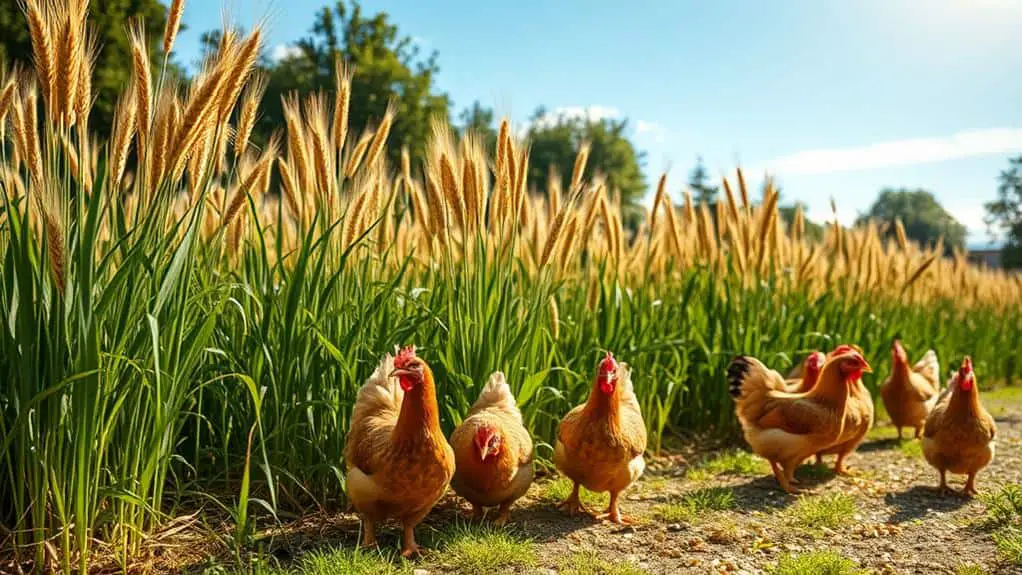
Growing wheat in your garden isn't just great for you; it's also fantastic for your poultry.
Wheat provides essential carbohydrates and proteins, making it a nutritious grain supplement that supports your birds' growth and egg production.
Plus, letting your chickens forage mature wheat stalks in their coop encourages natural behaviors and enriches their diet.
Nutritional Grain Supplement
Wheat is a fantastic addition to your poultry feed, offering essential carbohydrates, proteins, and fats that are crucial for your birds' health and productivity.
By including wheat in their diet, you guarantee they receive a well-rounded nutritional boost from this versatile grain.
Here are four key benefits of using wheat as a nutritional supplement for your poultry:
- Improved Growth: Wheat helps promote better growth and egg production in chickens and ducks.
- Balanced Diet: Combining wheat with other feed sources like insects and vegetable waste creates a varied and balanced diet.
- Enhanced Feather Quality: Regular consumption of wheat can lead to improved feather quality and overall vitality.
- Harvest Flexibility: You can harvest and grind wheat to the right size, making it suitable for chicks and mature birds alike.
Foraging and Enrichment
After discussing the nutritional benefits of wheat for your poultry, let's explore how it enhances their foraging and enrichment.
Growing wheat at home offers a chemical-free source of poultry feed, giving you peace of mind about its quality. Tossing mature wheat stalks into your birds' enclosure encourages natural foraging behavior. This not only keeps them busy but also enriches their environment.
The variety provided by wheat, alongside insects and vegetable waste, boosts the nutritional diversity of their diet. Wheat's essential carbohydrates and protein support your poultry's overall health and productivity.
Ground wheat is perfect for chicks, promoting their growth and development. By growing wheat, you're offering your flock a wholesome, enriching, and nutritious diet.
Educational Value
When you plant wheat in your garden, you're not just cultivating a crop but also sowing seeds of knowledge for your children. Growing wheat provides a hands-on educational experience that helps children learn about food origins and agricultural processes. It's amazing to see their curiosity bloom as they understand where their food comes from.
Here are some educational benefits:
- Historical Significance: Kids can connect with centuries-old farming traditions.
- Responsibility and Patience: They learn to care for their crop and wait for the harvest.
- Sustainable Practices: Teaching them about eco-friendly gardening techniques.
- Natural Ecosystems: Observing wheat's growth cycle sparks conversations about soil health and biodiversity.
Involving children in these activities fosters appreciation for sustainable practices and the effort behind every meal.
Planting Wheat
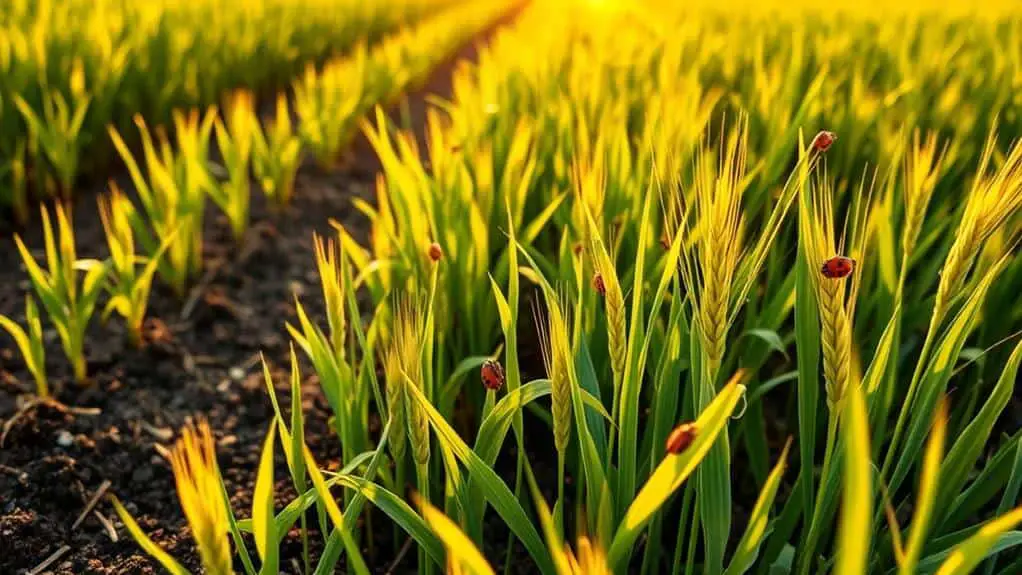
Planting wheat in your garden is a straightforward process that can yield rewarding results.
First, plant the wheat seeds after the danger of frost, usually around May 15. For every 100 square feet, use about half a pound of seeds. Evenly broadcast the seeds and cover them lightly with a rake. Wheat seeds can germinate even if left on the surface.
Make sure your soil is well-drained, gets full sun, and has balanced nutrients. Weekly watering of about a quarter inch is essential after planting to help with germination.
Growing whole wheat at home means you'll eventually thresh the wheat yourself. With proper care, you'll soon see the fruits of your labor in your garden.
Harvesting and Processing
Curious about how to know when your wheat is ready for harvest? Look for golden brown stalks and grain heads tipping downward.
To harvest the grain, follow these steps:
- Cut the wheat: Use garden shears for small plots or a scythe for larger areas.
- Bundle the stalks: Tie the dried wheat stalks into sheaves and let them dry in a well-ventilated area for 7-10 days.
- Thresh the grain: Use a broom handle to whack the dried wheat stalks and dislodge the wheat berries from the grain heads.
- Store properly: Keep the wheat berries in a cool, dry place to protect them from moisture and pests.
This process guarantees your homegrown wheat stays fresh and ready for use!
Frequently Asked Questions
Why Should I Plant Wheat?
Planting wheat offers health benefits from whole grains, diverse wheat varieties, and practical gardening tips. It supports sustainability practices like crop rotation, improves soil health, and fosters a deeper connection to food origins and self-sufficiency.
Is Growing Your Own Wheat Worth It?
Growing my own wheat is absolutely worth it. The wheat yield from home gardening is impressive, offering nutritional benefits. Plus, sustainable practices and crop rotation enhance soil health, making it a rewarding and educational experience.
Does Growing Wheat Help the Soil?
Growing wheat greatly benefits soil health. It aids in crop rotation, improves nitrogen fixation, and supports sustainable farming. Wheat prevents soil erosion, enhances water absorption, and enriches the soil, making it fertile for future plantings.
Why Is It Illegal to Grow Wheat at Home?
It's not illegal to grow wheat at home, but you need to check local wheat cultivation laws and home gardening regulations. Agricultural restrictions and legal implications can vary, so understand crop management guidelines to guarantee you're compliant.
Conclusion
Growing wheat in your garden is a fantastic choice. It's easy to care for, improves your soil, and provides delicious, nutritious grains for your family and poultry. Plus, it supports biodiversity. You'll enjoy the process, from planting to harvesting, and gain a better understanding of where your food comes from. So, why not give it a try? You might find it's not just beneficial but also incredibly rewarding. Happy gardening!

